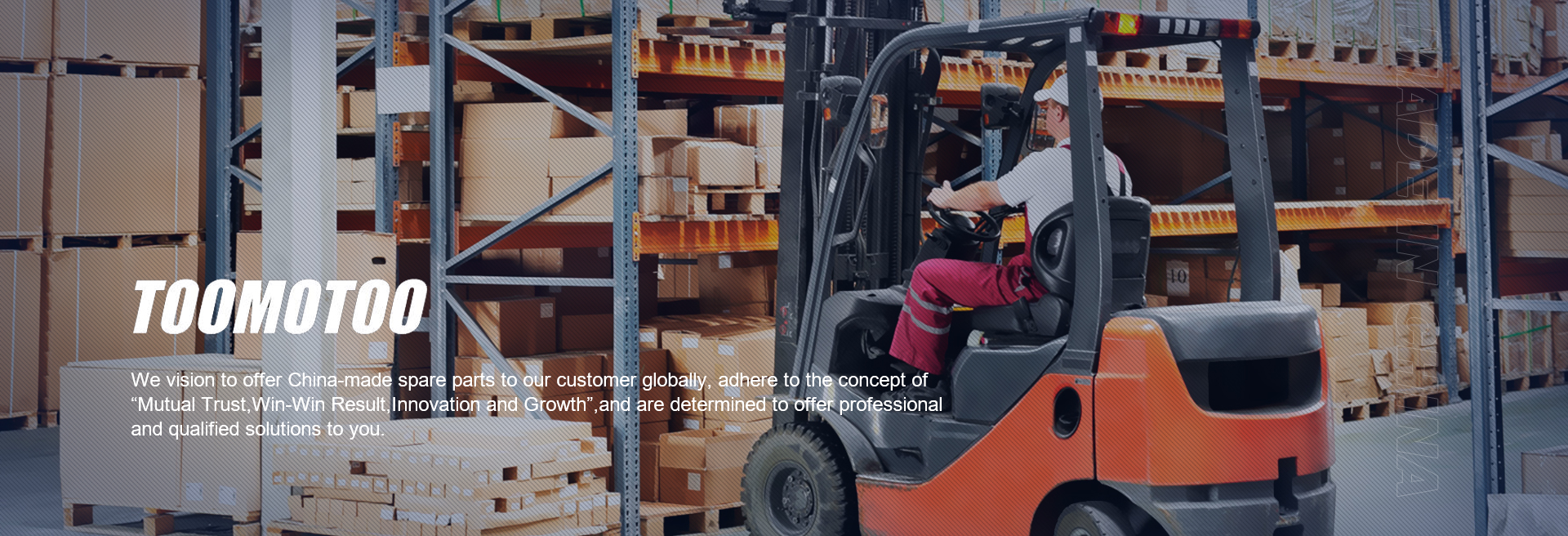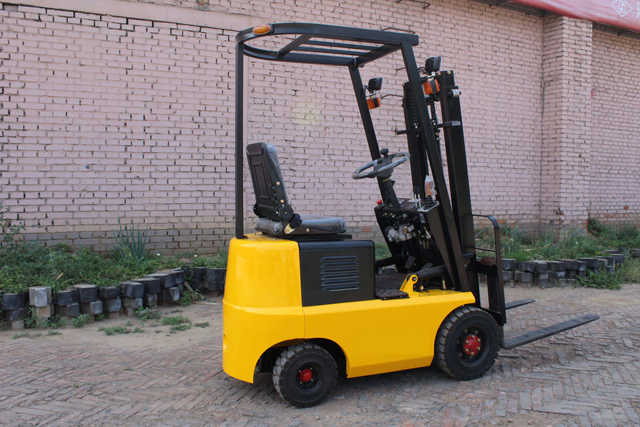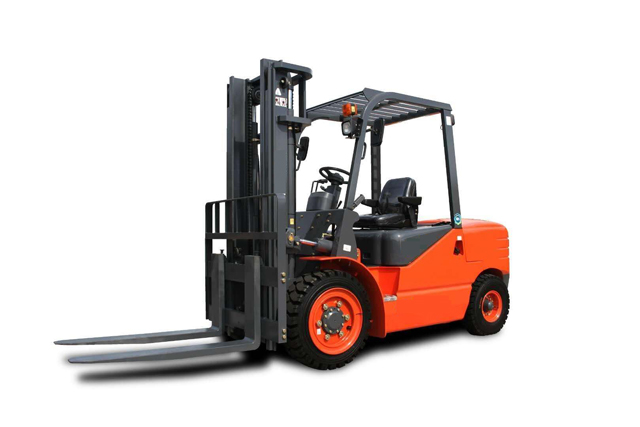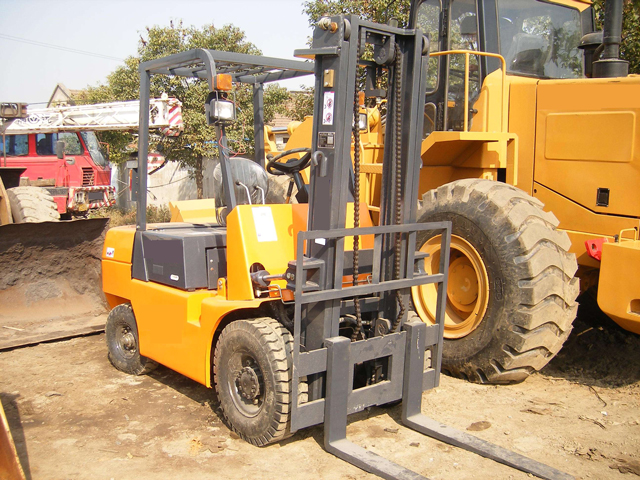
Time: 2022-09-16
Source: TOOMOTOO
Author: TOOMOTOO
Click: 819 times
In order to understand the structure and working principle of the forklift, analyze and compare the advantages and disadvantages of the power and internal combustion forklifts.
First, the overall structure of the forklift
There are many types of forklifts, but no matter what type of forklifts, they basically consist of the following four parts:
(1) Power part. Provide power for the forklift, generally installed at the rear of the forklift, and play the role of balancing weight.
(2) Chassis. Accept the power of the power unit to make the forklift move and ensure its normal walking.
(3) Working part. Used to fork and lift goods.
(4) Electrical equipment.
Due to the differences in the structure and installation position of the above 4 parts that make up the forklift, different types of forklifts are formed. Counterbalanced forklifts are one of the most common forms of forklifts. Below we take this type of forklift as an example to introduce the composition of each part of the forklift

1. power part
The power part of the internal combustion forklift is mostly powered by a reciprocating piston internal combustion engine. It has gasoline engine, diesel engine and liquid petroleum gas engine; the power device of electric forklift is composed of battery and DC series motor. In recent years, new types of forklifts have come out, and their power is dual fuel or dual power.
The drive train is the device that receives power and transmits it to the driving train. It generally has two kinds of mechanical transmission system and hydromechanical transmission system. The former consists of a friction clutch, a gear transmission, a universal transmission, a main drive and a differential installed in the drive axle; the latter replaces the friction clutch with a hydraulic pitch converter, and the rest is the same as the former. In recent years, a new type of forklift has come out, which adopts a full hydraulic transmission system. Reduced transmission components to ensure reliability.
2. Chassis part
The driving system is a device that ensures the rolling operation of the forklift and supports the entire forklift. It consists of brackets, axles, wheels and suspension devices. The front axle of the forklift is a drive axle, which is to increase the front axle axle load when carrying a load. , in order to improve the adhesion quality on the driving wheel and increase the ground adhesion to ensure that the driving force of the engine can be fully exerted. The rear axle is a steering axle. The steering device is located in front of the driver, and the levers such as the gear lever are placed on the right side of the driver's seat.
The steering system is a system used to make the forklift travel in the direction determined by the driver's wishes. The forklift steering system can be divided into two types: mechanical steering system and power steering system according to the energy required for steering. The former uses the driver's physical energy as the steering energy, and consists of three parts: the steering gear, the steering transmission mechanism and the operating mechanism; the latter is a steering device that uses the driver's physical energy and engine power as the steering energy. Under normal circumstances, only a small part of the energy required for forklift steering is provided by the driver, and most of it is provided by the engine. Supplied with steering booster. However, when the steering booster device fails, the driver should generally be able to independently undertake the steering task of the vehicle. When the forklift is operating, the steering and walking are changeable. In order to reduce the driver's manipulation burden, the internal combustion forklift adopts a power steering device. There are three types of power steering devices commonly used: integral power steering gear, semi-integrated power steering gear and steering booster.
The braking system is the system that slows down or stops the forklift. It consists of a brake and a brake transmission mechanism. The braking system can be divided into three types: manual braking system, dynamic braking system and servo braking system according to the braking energy. The former uses the driver's physical energy as the braking energy; the middle relies entirely on the potential energy in the form of air pressure or hydraulic pressure converted from the power of the engine as the braking energy; the latter is a combination of the former and the middle.
On the counterbalanced forklift, the back of the forklift is equipped with a counterweight to balance the quality of the goods in the front of the forklift.
3. working part
The working part is the direct working mechanism of the forklift for loading and unloading operations. It consists of the following 5 parts:
(1) Pick-up tool. It is a variety of work attachments represented by forks, which are used to fork, grip and shovel goods.
(2) Lifting shelves. It is used to install forks or other work attachments, and to drag the goods up and down together.
(3) Gantry. It is the skeleton of the working device, and most of the parts of the working device are installed on the gantry. The two-section gantry consists of an outer gantry and an inner gantry that can be lifted up and down along the outer gantry; the three-section gantry is composed of three inner, middle and outer gantry.
(4) Gantry tilting mechanism. The front and rear inclination of the gantry is realized, which is mainly composed of inclining oil cylinders.
(5) Lifting mechanism. The power unit and traction unit for dragging the cargo up and down. It is mainly composed of a sprocket, a chain and a lifting cylinder that drives the rack to rise and fall.
(6) Hydraulic control system. It is a combination of timely control devices for the lifting of goods, the inclination of the gantry and other actions completed by the hydraulic system. It consists of hydraulic components, pipelines and control mechanisms.
4. electrical equipment
Electrical equipment is mainly composed of batteries, forklift lighting, various warnings, alarm signal devices and other electrical components and lines. The battery forklift has a series-excited DC motor; the internal combustion engine forklift has an electric starter; in addition, the gasoline engine forklift has a high-voltage spark ignition device.

Second, the working principle of the forklift
Generally, forklifts are mostly balanced forklifts, just like seesaws, so the center of gravity of the load must be found first. This center of gravity is called the load center, which is half the length of the pallet. For example: the size of the pallet is length (D) 1000mm × width (W) 1200mm, then the load center is 500mm. Most of the load centers of forklifts are 500mm or 600mm, so when you want to know the standard load center of the forklift, you must find it from the specification table or forklift diagram of the forklift. The tonnage of the forklift refers to the maximum load value of the forklift loading, unloading and handling goods, which is designed according to the structural strength of each part, the hydraulic system pressure and stability, etc. The stability of the counterbalanced forklift is simply the lever principle (seesaw), In a critical state, if there is a slight force on the cargo side, the forklift will tip forward.
In vehicle design, the safety factor is generally set to ≥ 1.4 to ensure the safe operation of the forklift. The load curve table shows the relationship between the allowable load and the load center. Working within the range of the load table value can prevent accidents from happening.
Third,Comparison of internal combustion forklifts and electric forklifts
1. Characteristics and working environment of internal combustion forklifts:
(1). The counterbalanced diesel forklift has a large volume, but its stability is good, it is suitable for heavy loads, the use time is unlimited, and the use site is generally outdoors. Compared with gasoline engines, diesel engines have better power performance (not easy to stall at low speeds, overload capacity, and long-term operation capacity), and low fuel costs. The quantity can be from 0.5 tons to 45 tons.
(2). The counterweight gasoline forklift has a large volume, but its stability is good, it is suitable for heavy loads, the use time is unlimited, and the use site is generally outdoors. The gasoline engine is small in shape, light in weight, large in output power, low in noise and vibration, and low in price. However, the gasoline engine has poor overload capacity and long-term operation capacity, and the fuel cost is quite high. The load can be from 0.5 tons to 4.5 tons.
(3). The counterweight liquefied petroleum gas forklift (LPG for short) is a counterweight gasoline forklift equipped with a liquefied petroleum gas conversion device, that is, a LPG forklift, which can be switched between gasoline and liquefied gas through a changeover switch. The biggest advantage of LPG forklift is that it has good exhaust emission, carbon monoxide (CO) emission is significantly lower than that of gasoline engine, and fuel cost is low (15KG liquefied gas is equivalent to 20 liters of gasoline), which is suitable for indoor operations with high environmental requirements.
2. Characteristics and working environment of electric forklifts
(1) Electric pallet forklift
The main function of the electric pallet forklift is to realize the point-to-point movement of pallet goods on the plane, so there is no gantry lifting system, and it is suitable for places that focus on handling and do not need stacking. Three types with different costs.
(2) Electric pallet stacking forklift
The electric pallet stacking forklift is a light-duty indoor lifting and stacking equipment, focusing on the stacking function due to its light body. It is suitable for handling light and small materials in floor warehouses or other narrow places.
(3) Reach forklift
The hoisting mechanism of the reach forklift can move forward and backward in the longitudinal direction of the forklift. When picking up goods. The center of gravity of the cargo falls within the four fulcrums formed by the wheels. Therefore, the reach forklift has better flexibility, high lifting safety and stability. The load range is usually 1-2.5 tons, and the lifting height can reach 12 meters. But since the wheels are smaller. Passability is limited, and because of the complex structure and high cost, it is suitable for places with narrow space and high lifting height requirements, and is mostly used in high-rise warehouses.
(4) Universal electric forklift
The universal electric forklift can travel in all directions. In addition to the main characteristics of a counterbalanced forklift, the three wheels can drive in one direction at any angle, so the vehicle can be steered flexibly. steer and move the forklift in any direction. This model solves the problem of turning long materials in a narrow space, greatly saves space, and can realize oblique stacking and dismantling in train and car carriages.
(5) Four-way electric forklift
The four-way electric forklift integrates the functions of a reach forklift, side fork and counterbalanced forklift. In structure. It is basically the same as a reach-type forklift. The gantry is located between the front and rear wheels. There are two arm-like protruding legs in front of the truck. The front end of the legs is equipped with a support wheel, and the goods can follow the gantry in the longitudinal direction of the forklift. Move back and forth. When the fork is unloaded, the fork is extended, and after the fork is unloaded, the fork returns to the middle position close to the car body, so the stability of the forklift is greatly improved.
The difference from the reach forklift is that the two load-bearing wheels at the front end of the fork legs of the four-way electric forklift can be rotated by 90° through the steering mechanism. When the rear wheel turns 90°, the entire forklift can change from front to back to left and right on the spot. Travel, equivalent to a side fork, so it is suitable for long material handling in narrower aisles. The minimum channel width can usually be within 2 meters. However, due to the complex structure, the cost is high.
(6) VNA narrow aisle forklift
The main feature of the VNA narrow aisle forklift is that the gantry lifting mechanism can be rotated in three directions, and the car body does not need to be rotated during stacking, only the cargo or the gantry needs to be rotated. Therefore the channel width requirement is greatly reduced. At present, the minimum channel is below 1.8 meters. But at the same time. The aisle width also depends on the size of the tray. For example, it is still not possible to reduce the width of the aisle when handling long loads. In addition, in order to ensure the stability of the lateral stacking, the required weight of the whole machine is much larger than that of the three-pivot counterbalanced electric forklift, so the economy is slightly worse.
The following focuses on the reasonable selection of small tonnage counterbalanced forklifts.

Fourth, the advantages of the two forklifts
1. The electric forklift adopts electric drive. Compared with the internal combustion forklift, it has the advantages of no pollution, easy operation, energy saving and high efficiency. With the development of economy and the improvement of environmental protection and energy saving requirements, electric forklifts have developed rapidly. Market sales are increasing year by year. Especially in ports, storage and tobacco, food, textile and other industries, electric forklifts are gradually replacing internal combustion forklifts.
2. Compared with electric forklifts, internal combustion forklifts have good stability, are suitable for heavy loads, have unlimited use time, and are generally used outdoors, such as construction sites and docks.
Fifth,Summary
The two types of forklifts have their own characteristics and shortcomings, and they also have their own living space, so there is no one of them that completely replaces the other, and their practical significance can be summarized as follows
1. High production efficiency and low operating cost.
Mechanized handling not only takes less time than traditional manual handling, but also reduces labor expenditure and cost and improves work efficiency. In the same handling cycle, the number of movements of the forklift is significantly reduced, the corresponding tires, transmission gears, and fuel consumption of the forklift are also reduced accordingly, and the operating cost is also reduced accordingly.
2. The operation is safe and reliable, reducing the accident rate.
The attachments designed and produced by professional forklift attachment manufacturers for different industrial working conditions are designed with safety devices, so that the clamped (or fork) goods are not easy to slip off under abnormal conditions, such as the pressure-maintaining device of the clamp type attachment; The end buffer device of the side-shifting attachment, etc., reduces the accident rate.
3. The loss of goods is small.
With the help of the special functions of clamping, sideshifting, rotating, etc., the goods can be transported or stacked or loaded and unloaded more safely, thus minimizing the loss of goods. The use of attachments also reduces the frequency of use of pallets, and the corresponding procurement and maintenance costs are also reduced.
With the wide application of forklifts, they are suitable for various environments and forklifts under various conditions have been developed one after another. Therefore, different users can consider different types of forklifts according to their actual needs.
<< Previous page
Next page >>
LINKS:
Harber Metal